Official Name
Brno. Another word with a lack of vowels! As far as I know, a weak 'e' as in 'set' is added between 'r' and 'n'. The German name Brünn is easier to pronounce and quite famous, since Brno was an important town within the Austrian monarchy. The city is famous as a trade fair town and venue for Grand Prix races.
Location

| ||
| Brno |
In the southeast corner of the Czech republic, some 180 km as the crow flies south-east of →Prague and only 100 km north of Vienna. Brno is located in the centre of Moravia - the Eastern part of the Czech republic.
Population
Brno has around 387,000 inhabitants and therefore it is Czech's second biggest city and by far the biggest city in Moravia.
Orientation
The town is surrounded by mountains except for the lowland in the south. There, the small river Svratka crosses the city, although it's quite away from the city centre.
Some hills can be found in the middle of the city, which predestined the place to have a huge castle built on top of one of the hills. The historical city centre itself is quite unusual. There is a distinctive outer ring road and - strange enough - some bigger squares, but the streets inside the ring are rather chaotic and do not show a certain scheme. The bus terminal is around 1 km away from the city centre in the south-east of town. The main train station can be found between the city centre and the bus terminal. Some tunnels connect the terminal with pedestrian zones on the other side of the road. There's a tram station in the middle of the road in front of the station. The tunnels do not really leave a good first impression. When walking along the pedestrian zone Masarykova northwards, it takes around 5 minutes to get to nám. Svobody (Liberation square) - one of the biggest central squares in Brno. Almost all places of interest gather around the square. The vast hrad Špilberk (Spilberk castle) towers above the city on a hill in the west and cannot be missed. It takes around 10 minutes to walk there from the central square. Thanks to the castle and the twin-towered Katedrála sv. Petra a Pavla (St. Peter & Paul-Cathedral) it's quite easy to orientate.

| ||
| View from the old city hall: Left: St. Peter & Paul-Cathedral, Middle: Spilberk castle and St. Michael Church, right: St. Jakob Church |
All sights in Brno are accessible on foot but it takes some time. A walk through the entire city centre including the castle takes around 2 to 3 hrs - of course without going to museums. Attention: The whole seems to be in transition - there are construction sites everywhere. Some tram lines are not working. It didn't look like it will be finished in the near future (as of April 2004).
History
The area around Brno had been populated a long time ago. However, the city's history started around the year 1000 A.D. In present-day Staré Brno (Altbrünn, old Brno), a first settlement next to a ford at the Svratka river was founded. The Spilberk (Spielberg) castle was mentioned first in 1277, and eversince the history of the castle was strongly connected to the history of the town. Brno played an important clerical role after the 14th century. At first, a Cistercian monastery was founded. Later on, Augustinians (predominantly Dominicans) and Capuchins decided to build monasteries in Brno.
In 1349, the city was chosen as residence of Moravian lords, but it wasn't before 1641 that Brno became the capital of Moravia. Since 1560, the Spilberk castle belonged to the city. Brno was heavily fortified and therefore could even resist attacks from Hussites in the 15th century, Swedish troops in the 17th century and Prussians in the 18th century. The latter besieged the city for a long time but weren't successful. Nevertheless, only 5000 people lived in the city after the 30 years' war.
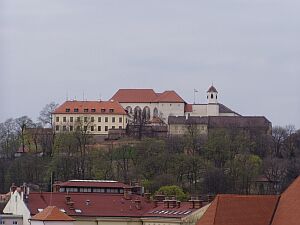
| ||
| The marvellous Spilberk castle |
Only Napoleon could make it to Brno. Not far from Slavkov u Brna, better known as Austerlitz and only 20 km away from Brno, Napoleon managed to defeat the united armies of Austria and Russia in 1805.
In the 19th century, during the Habsburg reign, Brno was widely industrialised. Many textile and machine factories started business. Already in 1839, the railway line from Vienna to Brünn aka Brno was completed. Gasworks and tram lines were established, and so Brno became a progressive city. Around the same time, the Augustinian monk Mendel researched on plants and put forward first laws of heredity - an epoch-making theory which started genetic science.
To make things complete, some institutes of technology and universities were founded in the 19th century. Another boom was produced by building trade fair facilities in 1928. Since 1959, annual mechanical engineering fairs are held in Brno. Starting in the 1990ies, the city hosts the Czech constitutional court and a modern technology park. As mentioned above, the town is in transition - many buildings and bigger parts of infrastructure are being renewed or redesigned. As a matter of fact, Brno is an imortant and highly dynamic place with growing importance for the middle of Europe.
Getting there / transportation
Brno is the second biggest city of the Czech republic, and so road and railroad connections are very good. There's even an international airport nearby. Some EuroCity trains pass Brno - among them a direct train from Berlin (less then 8 hrs) via →Prague (2hrs 45'), Bratislava (1hr 15') to →Budapest (4 hrs). From Vienna, it only takes 1 hr 45 minutes. Connection to other Czech cities is quite good as well. However, when heading for places in South Bohemia, e.g. →České Budějovice or →Český Krumlov, it's better to take a bus since railroad connections are rather bad.
Visitors to Brno should not miss a walk to the huge hrad Špilberk (Spielberg castle) west of the city centre. Originally constructed as a gothic fortress in the 13th century, the castle underwent several major reconstruction processes. In the 17th century, Spilberk castle was redesigned as a large baroque fortification system. Today, the castle lines up with other great Habsburg citadels such as →Terezín or →Petrovaradin (Novi Sad).
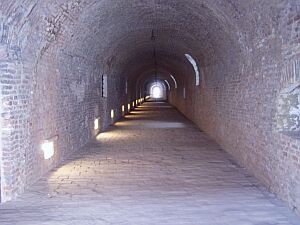
| ||
| The casemates inside the castle |
The castle is atop a hill and surrounded by a beautiful park. By far the most interesting part of the castle are the casemates (underground prison), which was used as a dungeon since the 17th century. Here, the Habsburg monarchy's most dangerous and most feared criminals had been imprisoned. It was abolished in 1855, but until then the casemates of Spilberk were infamous and considered to be the fiercest gaol throughout the Austrian empire. However, the casemates became a tourist attraction already in 1880. Many things have changed since the prison was abolished. A torture chamber had been added, which actually never existed during the time as it was used as a prison.
The casemates consist of two levels, arranged in a big rectangle. It's possible to see a small part of the lower level and the entire upper level. Both levels are above the surface, but once inside, it feels like being a few meters below surface. A small part of the circuit is outside the building, but the rest leads the visitor through dark, cold and endless hallways. The atmosphere is a bit spooky - just imagine the screams of the poor prisoners starving in their cells. Entrance fee is 30 kč (students 15). The actual castle with its courtyards is above the casemates - just pass the casemates and walk through a long and narrow gate. Inside the castle there is the Muzeum Města Brna (City Museum), an observation tower (extra fee) and a restaurant.
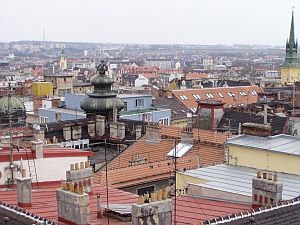
| ||
| Mary Poppins? Above the roofs of Brno... |
Another good idea is to simply criss-cross the old city centre. Many nice buidlings of several epochs can be seen. Hence buildings of many different styles stand next to each other, which is quite colourful. Unfortunately, old buildings have not been maintained at all in socialist times, and so some of the structures are in a desolate state. As in all other socialist countries, top priority was given to building countless new apartment blocks in the suburbs to create as much housing as possible instead of costly reconstructing historical buildings. Today Brno is trying hard to save as much as possible. The visitor will miss the homogeneity of smaller Czech cities, which doesn't mean that there's a lack of spectacular places. Among them, the Stará Radnice (old city hall) facing the northern side of Zelný trh (green square) should be mentioned. The square itself is still used as a market square. The tower inside the old city hall looks like a big green water tower and is easy to find.

| ||
| In the old city centre (Joštova-St.) |
It's possible to climb the tower, which is not a bad idea, since you can overlook the entire old city centre (see panorama above). Admission fee is Kč 10. Add a handful of Crowns and you can visit some of the old rooms inside the city hall. The courtyard and the gothic portal are very interesting as well. The latter impresses by a funny detail (see photo below).
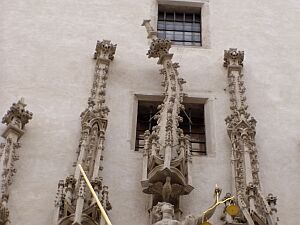
| ||
| It probably disturbed the view... |
Other interesting places include the Moravské zemské muzeum (Moravian museum) near the train station and the huge black Katedrála sv. Petra a Pavla (St. Peter & Paul Cathedral). The history of this striking church started in the 11th century as a basilica, before it was transformed into a gothic cathedral during the 14th century. However, many details were changed until the 20th century. The size of the cathedral as well as the beautiful stained glass are very impressive indeed.
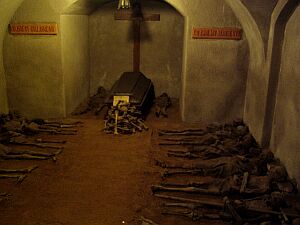
| ||
| The old sleeping room of the Capuchin monks |
Going all the way to →Egypt just to see some dried-up mummies is too much hassle? Then you may go to the Capuchins church in the Capuchins street between the Moravian museum and the main train station. In the vaults of the church, some mummified corpses, most of them monks and noblemen from around the 18th century, are on display. Unfortunately, explanations are poor and mostly in Czech only. Entrance fee is Kč 40, students pay half.
No specific recommendation, because I've stayed outside the city. There are many pensions and hotels in town. Please note that Brno is a trade fair city and therefore all accommodations can be booked out - especially in February, April and September. There are camping sites out of town.
- www.brno.cz/ Official website of Brno with plenty of infomation. Good reading to start with. Comes in English, Czech and German.
Do you have or do you know a good website about Brno? Don't hesitate, let me know! After checking it, I would love to add it to the link list. You can submit a link by using the →contact form. Note that commercial websites will be treated differently.
©2024 Europe-East.com

 Albania
Albania Czech Republic
Czech Republic